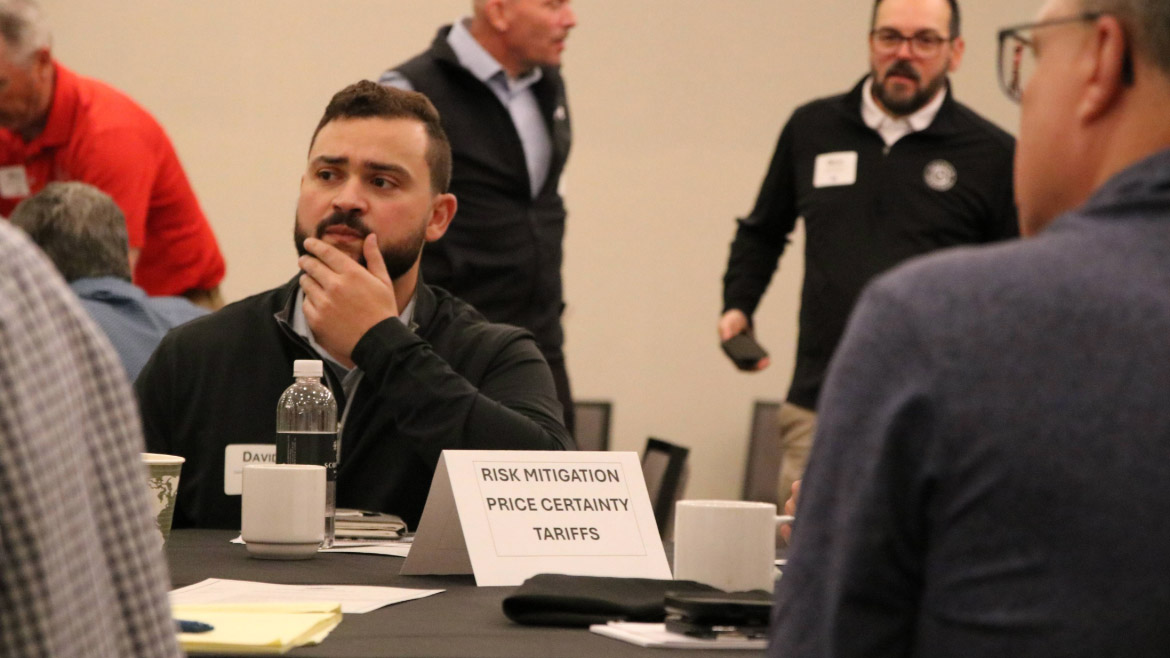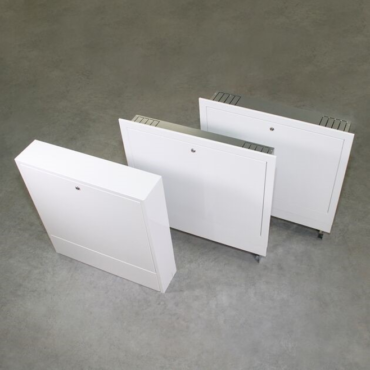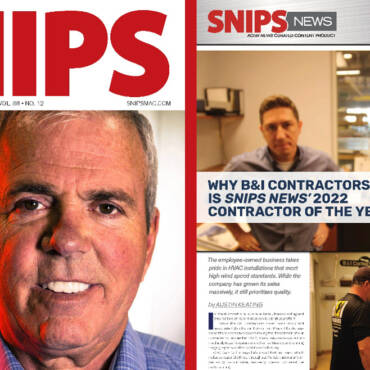At the annual meeting of the Spiral Duct Manufacturers Association (SPIDA) in May, industry leaders from both the union and non-union sides of the sheet metal industry gathered to confront a common problem: how to plan around trade policy in a climate that feels radically more uncertain than just a few years ago.
Stan Kolbe, executive director of government and political affairs at the Sheet Metal and Air Conditioning Contractors’ National Association (SMACNA), says the environment for contractors now is “far more challenging” than when the 2017 tax code was written during the first Trump administration. But to deal with the impact of tariffs, the sheet metal industry and wider U.S. Chamber of Commerce is calling for tax relief.
“We’re in a declining economy with sinking revenues, frozen projects, infrastructure clawbacks, and spiking material costs on top of rising supply chain barriers,” Kolbe explained, noting the Trump administration’s plans to use a “big, beautiful” tax cut bill to bring tariff relief is fraught, as hardliners in his party will not agree to substantial tax cuts without significant cuts to spending, including politically unpalatable cuts to Medicare.
“We need the 2017 code on steroids with significant targeted relief for tariffs created dislocations: bonus depreciation, expensing of equipment (including the tariff fee), etc.,” Kolbe said. “The economic patient needs more of a transfusion this time around.”
Steel is the lifeblood of sheet metal shops, putting them squarely in the crossfire of tariffs, volatile prices, and supply chain disruptions. John Cologgi of Olympic Steel set the tone in his address at the SPIDA meeting.
“Inventory levels are trending lower as we head into 2025,” Cologgi told the audience. “With the new administration, there’s just a lot of uncertainty as we go forward. There’s plenty of steel to be bought from the mill standpoint, but we’ve got to figure out which way the country wants to go with the tariffs.”
He painted a picture of a market in limbo: galvanized steel imports have “fallen off a cliff” since tariffs increased last year, and buyers are wary of restocking inventory when tomorrow’s costs and availability are impossible to predict.
“Nobody wants to bring in steel when they can’t get rid of it, or don’t know what it’ll cost next month,” Cologgi said, summing up the anxiety many in the room shared.
The pressure is not limited to imports. In early May, Cleveland-Cliffs — one of the country’s major steel producers and a significant source of steel to the HVAC and construction sectors — announced it would fully or partially idle six facilities and scrap plans for a new transformer plant in West Virginia. CEO Lourenco Goncalves cited “the lagging effect of lower index prices in late 2024 and early 2025” as well as “non-core assets,” in moves designed to save more than $300 million annually and boost operational efficiency.
These moves are already having ripple effects, with concerns that similar cutbacks could further squeeze supply and push costs even higher for downstream users like duct manufacturers.
For companies that rely on a steady, affordable supply of steel, the prospect of reduced domestic production and ongoing trade uncertainties is a double blow.
“It’s not just about price — it’s about predictability. And right now, every part of the supply chain is more unpredictable than ever,” Cologgi noted. This unpredictability is putting some contractors on edge. March saw construction job openings plummet by 38,000—the biggest single-month drop in years — while unfilled jobs fell to 248,000, a 27% decline from last year. The hiring rate in the sector shrank to just 3.6%, with both quitting and layoff activity subdued, suggesting that the labor market is tightening and churn is slowing.
Stan Kolbe, executive director of government and political affairs at the Sheet Metal and Air Conditioning Contractors’ National Association (SMACNA), added to the chorus of concern at SPIDA.
Tax Relief for HVAC and Sheet Metal Contractors
In a candid discussion, Kolbe warned that the current environment — characterized by high tariffs and uncertainty — could become devastating for contractors and manufacturers.
“To extend the status quo in a declining economy with historically high tariff assessments, record infrastructure freezes, and layoffs is by definition not a stimulus environment,” Kolbe said. He also emphasized that many economists now see a greater than 50% risk of recession.
Kolbe pointed out that without meaningful new tax stimulus, the sector is being forced to shoulder “the tariff lead weight around the economy’s growth rate … assuming we are even growing any longer.” GDP, or gross domestic product, fell to an annualized rate of -0.3% in the first quarter of this year, according to Commerce Department data released April 30. Kolbe cautioned that simply preserving 2017’s tax incentives, in combination with hundreds of billions in new tariff fees, could rapidly escalate any decline the industry is experiencing — “locking in recession,” Kolbe said.
The national business community is amplifying these calls for relief. In a letter to the administration on May 1, the U.S. Chamber of Commerce urged immediate action: automatic exclusions for small business importers, a formal process for companies to seek relief if tariffs threaten American jobs, and exemptions for products not produced or sufficiently available in the U.S. — steel included.
“As each day goes by, small businesses are increasingly endangered by higher costs and interrupted supply chains that will cause irreparable harm,” Chamber President and CEO Suzanne P. Clark warned. She applauded efforts to negotiate new trade agreements but stressed that “many businesses simply can’t afford to wait while negotiations proceed.”
All previous general approved exclusions (GAEs) and country-level exemptions for Section 232 steel tariffs were revoked effective March 12. This means that the 25% tariff now applies broadly to nearly all steel imports, including galvanized steel, regardless of country of origin. The Commerce Department also stopped accepting new exclusion requests as of February 10, 2025, and the official exclusion process has been terminated, making it impossible for companies to apply for new product-specific exemptions at this time
Meanwhile, on Capitol Hill and across industry circles, debate rages over the administration’s assertion — echoed by senior advisor Stephen Miller — that the “largest tax cut in American history” will offset the pain of tariffs for small businesses sufficiently. When asked about the Chamber statement, Miller told reporters the relief for small businesses would come in the form of expanded tax cuts, including 100% expensing for investments in the United States, not short-term tariff relief.
“This will be the most pro-small business tax bill in American history,” Miller said, arguing that U.S.-based production and supply chains will mean “no tariff because their production … will be in the United States.”
Yet for the HVAC and sheet metal sectors, such promises offer cold comfort when faced with immediate cash flow crunches, shrinking access to affordable steel, and the very real prospect of layoffs and canceled projects. As Kolbe noted, “status quo tax writing and only preserving the same incentives already on the books won’t move the needle enough or at all for businesses in construction.”“We have offered Congress that they need to do in part: speed up full payment on completion change order resolution, offer credits against equipment tariff fees, and that the federal government allow material cost escalation adjustments to ongoing projects where the government’s actions alone caused spikes eating deeply into profits,” Kolbe added, noting that failing this, “we will see less construction and few if any profits for those building.”
Industry data backs up these concerns. Reports from groups like the Associated General Contractors (AGC) show that some of the largest construction buyers expect to pay as much as $10 billion in tariffs — a “negative indicator for jobs and profits,” Kolbe said, and a brake on building expansion nationwide.
The Cleveland-Cliffs announcement, meanwhile, may only be the precursor to further contractions in the domestic steel industry, as more mills could follow suit if prices remain weak and tariffs continue to disrupt global supply chains. All of this comes while federal infrastructure initiatives — promised as a boom for the sector — are being slowed by budget freezes, delays, and political gridlock, leaving many businesses in limbo.
As Congress and the administration debate the next round of relief, the message from manufacturers, suppliers, and contractors is clear: steel isn’t just another commodity — it’s the foundation of the industry. Without swift, targeted action on tariffs and trade policy, the spiral duct and sheet metal sectors could face a summer of higher prices, unpredictable supply, and mounting uncertainty — with no easy fix on the horizon.
Whether you require installation, repair, or maintenance, our technicians will assist you with top-quality service at any time of the day or night. Take comfort in knowing your indoor air quality is the best it can be with MOE heating & cooling services Ontario's solution for heating, air conditioning, and ventilation that’s cooler than the rest.
Contact us to schedule a visit. Our qualified team of technicians, are always ready to help you and guide you for heating and cooling issues. Weather you want to replace an old furnace or install a brand new air conditioner, we are here to help you. Our main office is at Kitchener but we can service most of Ontario's cities
Source link



